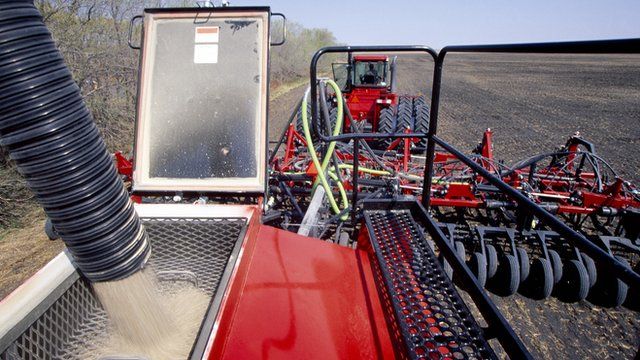'Laughing gas' emissions from farming understated in US
- Published

Emissions of nitrous oxide (N2O) from agriculture in some locations are underestimated by 40% according to new research.
The gas is a significant threat as it contributes both to global warming and the destruction of the ozone layer.
Intensive farming and the use of fertilisers are the biggest human sources of the substance.
This new study adds to a body of evidence that N2O is a far bigger problem than previously thought.
Nitrous oxide was once used as a dental anaesthetic but there have been growing concerns about the use of what's sometimes called "laughing gas" as a legal high. There have been worries that the chemical's abuse has been linked to several deaths.
Double threat
After carbon dioxide and methane, nitrous oxide is believed to be the largest factor in climate change, accounting for 6% of the warming from human sources.
N2O poses a "double whammy" threat because it is now the single biggest risk to the ozone layer.
But accurately estimating and measuring emissions of N2O has proven very difficult.
Scientists have attempted to model how much is likely to be emitted by adding up the amounts of nitrogen used as a fertiliser, which is the single biggest human-contributed source.
But these estimates haven't tallied with measurements collected by aircraft and by tall-tower sampling.
To try and reconcile these differences researchers looked at the US corn belt region, an area with intensive farming that relies on the heavy use of nitrogen fertilisers.
The corn belt covers an area of around 60 million hectares and is of considerable importance in global food production.
In the study the scientists looked at the possibility that as well as coming directly from soils, there are significant indirect emissions from rivers and streams in the corn belt region where nitrogen from the soil often ends up.
By examining the levels of nitrous oxide in 19 rivers and streams, they concluded that there has been a significant underestimation of this source.
"Even very small amounts of N2O can be very harmful from a greenhouse gas balance perspective," lead author Peter Turner, from the University of Minnesota, told BBC News.
"We found that there was a nine fold underestimation with streams in the area, which translates to about a a 40% underestimation of the agricultural budget."
The researchers believe that their results may also be applicable to similar areas of intensive agriculture in Europe, China and India. They argue that to deal with the problem requires more efficient use of nitrogen in farming in these areas.
"Any of the discussions that centre on the mitigation of N2O in agriculture revolve around improving the nitrogen use efficiency of the crop - that's the ratio of the amount of nitrogen that's used by the plant to the amount that's applied and that's sometimes around 50%," said Peter Turner.
"The remaining nitrogen is either lost or stays in the soil and that represents the potential for future N2O emissions, so if there is any way to improve the nitrogen use efficiency, that could mitigate the emissions while not jeopardising farmer's incomes."
Other scientists in this field agree that getting a grip of nitrous oxide requires much better information on the scale of emissions and their sources. This new study from an area with detailed records of nitrogen use might serve as benchmark for areas that don't have accurate information.
"In the global context, this could also have large implications for regions of the world where there are large agricultural sources and where we may not have the measurement coverage to assess emissions using atmospheric measurements," Dr Anita Ganesan from the University of Bristol told BBC News.
"Through this study, we may be able to improve "bottom-up" models to better account for these hotspot emissions."
The new research has been published in the journal Proceedings of the National Academy of Sciences.
Follow Matt on Twitter @mattmcgrathbbc.
- Published26 July 2015
- Published21 July 2015
- Published9 April 2015